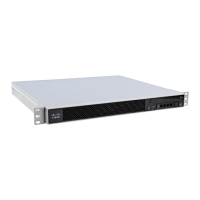1-2
Cisco ASA Series CLI Configuration Guide
Chapter 1 Getting Started
Accessing the ASA Services Module Command-Line Interface
The following prompt appears:
Password:
All non-configuration commands are available in privileged EXEC mode. You can also enter
configuration mode from privileged EXEC mode.
Step 4 Enter the enable password at the prompt.
By default, the password is blank, and you can press the Enter key to continue. See the “Configuring
the Hostname, Domain Name, and Passwords” section on page 1-1 to change the enable password.
The prompt changes to:
hostname#
To exit privileged mode, enter the disable, exit, or quit command.
Step 5 To access global configuration mode, enter the following command:
hostname# configure terminal
The prompt changes to the following:
hostname(config)#
You can begin to configure the ASA from global configuration mode. To exit global configuration mode,
enter the exit, quit, or end command.
Accessing the ASA Services Module Command-Line
Interface
For initial configuration, access the command-line interface by connecting to the switch (either to the
console port or remotely using Telnet or SSH) and then connecting to the ASASM. This section
describes how to access the ASASM CLI, and includes the following sections:
• Logging Into the ASA Services Module, page 1-2
• Logging Out of a Console Session, page 1-5
• Logging Out of a Telnet Session, page 1-6
Logging Into the ASA Services Module
For initial configuration, access the command-line interface by connecting to the switch (either to the
switch console port or remotely using Telnet or SSH) and then connecting to the ASASM.
If your system is already in multiple context mode, then accessing the ASASM from the switch places
you in the system execution space. See Chapter 1, “Configuring Multiple Context Mode,” for more
information about multiple context mode.
Later, you can configure remote access directly to the ASASM using Telnet or SSH according to the
“Configuring ASA Access for ASDM, Telnet, or SSH” section on page 1-1.
This section includes the following topics:
• Information About Connection Methods, page 1-3

